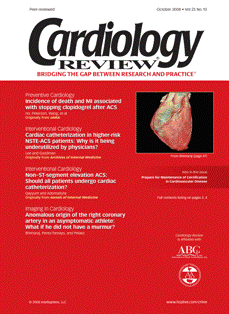Publication
Article
Cardiology Review® Online
Anomalous origin of the right coronary artery in an asymptomatic athlete: What if he did not have a murmur?
Author(s):
Sudden death in young athletes is shocking because it is unexpected in these seemingly healthy individuals. We present the case of an athlete who was found to have an incidental murmur during a screening physical, which led to a diagnosis of an anomalous origin of the right coronary artery with an intramural course. This congenital anomaly has been well recognized to result in sudden death; thus, it was fortunate that the condition was identified in our patient. We provide a brief overview of the literature, discuss the challenges faced in diagnosing such coronary abnormalities, and review the various management options that are available.
Sudden death in young athletes is shocking because it is unexpected in these seemingly healthy individuals. We present the case of an athlete who was found to have an incidental murmur during a screening physical, which led to a diagnosis of an anomalous origin of the right coronary artery with an intramural course. This congenital anomaly has been well recognized to result in sudden death; thus, it was fortunate that the condition was identified in our patient. We provide a brief overview of the literature, discuss the challenges faced in diagnosing such coronary abnormalities, and review the various management options that are available.
Case report
A healthy, athletic, 25-year-old black man was referred to our institution for evaluation of a short systolic murmur. A two-dimensional echocardiogram (2DE) showed mild mitral regurgitation and a coronary artery coursing between the aorta and the right ventricular outflow tract (Figure 1). Computed tomography angiography showed the right coronary artery originating from a separate cusp on the left side of the aortic root inferoposterior to the left cusp; it had an interarterial course (Figure 2).
Although the patient’s exercise stress test was normal, he was referred for cardiac surgery and underwent an unroofing of the right coronary artery because of his desire to pursue professional basketball. After initiating cardiopulmonary bypass surgery, the aorta was cross-clamped, the heart arrested, and an aortotomy was created to expose the slit-like narrow orifice of the right coronary artery (Figure 3). A right-angle clamp was inserted into the ostium. Cutting over the clamp unroofed the intramural course of the right coronary artery (Figure 4). The aorta was then anastamosed to the right coronary artery in a side-to-side fashion using 6-0 polypropylene (Prolene) sutures, creating a 1.25-cm neoostium (Figure 5). The patient had an uneventful recovery and was discharged from the hospital on postoperative day 7. Within 1 year of the procedure, he returned to professional basketball.
Hypertrophic cardiomyopathy is the most common cause of sudden death in young athletes, followed by commotio cordis and coronary artery anomalies.1 As a single entity, congenital coronary anomalies of wrong sinus origin are the second most common cardiovascular cause of sudden death in young athletes.
An anomalous origin of the right coronary artery is rarely observed, with a reported incidence between 0.026% and 0.25%.2 The condition appears to be more prevalent in nonwhites,2 but the true incidence in all populations is unknown because most individuals are asymptomatic. An autopsy study by Basso and colleagues found that only 37% of right coronary arteries with an anomalous origin caused symptoms before resulting in sudden death.3
Right coronary arteries with an anomalous origin can run anterior to the pulmonary trunk or have an interarterial or retroaortic course. An interarterial course can compromise blood flow by compressing the right coronary artery between the aortic and pulmonary trunks upon dilation of the great vessels, such as occurs during physical exertion or after alcohol consumption. Kinking at the origin, collapse of the slit-like ostium upon exertion, intramural compression, or proximal intussusception secondary to the tangential proximal course of the artery are some other mechanisms postulated to compromise coronary blood flow, which can manifest as angina, palpitations, syncope, dyspnea, or even sudden death.
Diagnosis
Most patients have a normal 2DE, exercise stress test, and perfusion scan.4 Transthoracic echocardiography has a low sensitivity for detecting coronary anomalies in adults.5 Contrary to these findings, a 2DE demonstrated the anomaly in our patient. Although some clinicians recommend cardiac catheterization before surgery, noninvasive imaging techniques might make this step unnecessary, as illustrated by our case. While noninvasive imaging seems to be a promising screening tool for young athletes, the number of eligible individuals (10 million-12 million) makes this impractical.
Treatment
Surgical correction is the gold standard in treating an anomalous origin of the right coronary artery; however, because of the rarity of this condition, there is no consensus on the timing of surgery. Some experts recommend correction in only symptomatic patients or in those with occupations that require extreme physical exertion, such as competitive sports.
Percutaneous coronary intervention has been performed in the setting of acute myocardial infarction, but this approach is fraught with technical difficulties. Coronary artery bypass graft (CABG) surgery, reimplantation of the ostium, and unroofing of the coronary artery are surgical options. Unroofing has better outcomes,4,6 but requires the intramural course to be at or below the level of the commissures. Poor long-term patency of vein grafts and issues with maturation of arterial conduits secondary to competitive flow limits the usefulness of CABG surgery. Reimplantation is technically challenging and there is a predisposition to kinking.
Conclusions
Congenital coronary abnormalities are often difficult to diagnose because most patients are asymptomatic. One can only surmise the outcome in our patient had his murmur not been detected, as it led to the diagnosis. Fortunately, imaging technology continues to improve; thus, these anomalies may be identified more readily in the future, increasing our understanding of just how prevalent these and other coronary anomalies are.






